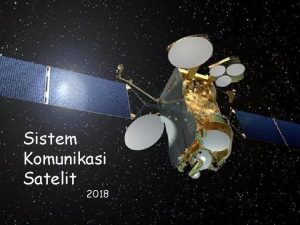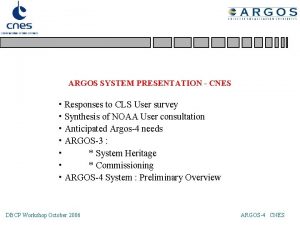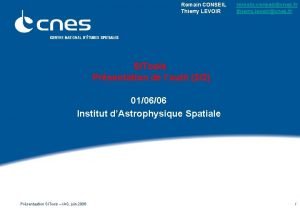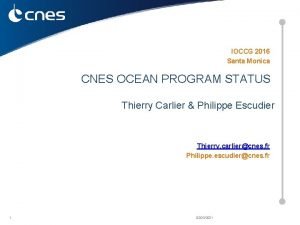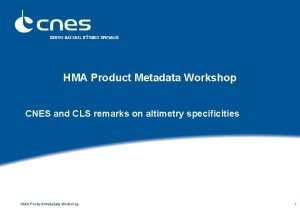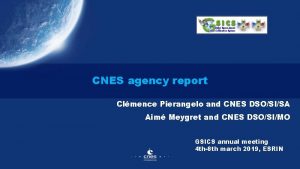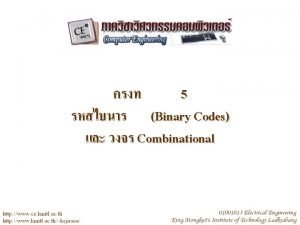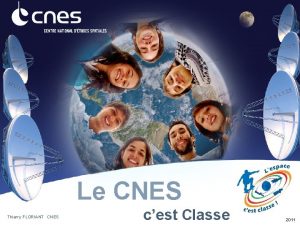CNES agency report CNES Digital Solutions Ground Segment










- Slides: 10

CNES agency report CNES Digital Solutions, Ground Segment & Operations Directorate (DNO) Earth Observation Department (OT)

CNES objectives : increase the usage of space data v 2016 : creation of a new directorate dedicated to Innovation, Application and Science v 2017 : creation of a new directorate “Digital solutions, Ground-Segments & operations” v 1 department dedicated to IT infrastructure : big data, HPC, machine learning, architecture v 1 department dedicated to science v 1 department dedicated to Earth Observation v… 2

EO department : scope of activities v Our main objective : promote the best possible use of Earth Observation data v Involvement in Space missions : Ø Payload Ground Segment Development (Programming, Payload processing, Instrument Expertise Centers, …) Ø Operations : - Mission management (hand-over from “Orbital System directorate” after in-orbit commissionning) - Payload Ground Segment operations v Value-added products Ø CNES contribution to Data and Service hubs v Innovation in Ground segment design Ø Benefice of big data/cloud technologies for improved performances 3

OBSERVATION Scientific Data and service hubs At the end of 2013, CNES and its scientific partners agreed to set up four hubs for Earth Observation data and services (solid earth, ocean, land surfaces and atmosphere), for coordinated management, centralised access to data and derived thematic products from these data, as well as the associated expertise. AERIS: The atmosphere pole consists of 4 data and service centres (CDS): Icare (clouds, aerosols, radiation, etc. ), ESPRI (chemistry of the atmosphere, etc. ), Sedoo (data measurement campaigns), SATMOS (data from geostationary satellites and derived cloud products, etc. ) ODATIS: Promote and facilitate the use of observations made in the ocean or at its interface with the other environmental compartments. The main contribution of CNES concerns altimetry activities. THEIA: Promote and facilitate the use of observations specifically of land surfaces, covering several themes: agriculture, forests, hydrology, health, urban planning, risk assessment, etc. FORM@TER: The mission of the solid Earth pole is to facilitate and enhance the use of in situ and satellite data and products related to the different thematic areas concerning the solid Earth (geodesy, magnetism, gravimetry, tectonics, geodynamics, volcanology, etc. ) for the needs of different communities working on the Earth system. Work on progress: to constitute a unique research infrastructure federating these four data hubs according to the following themes: Earth Scientific Data and service hub 4

OBSERVATION PEPS: Sentinel Products Exploitation Platform, French Copernicus collaborative ground segment With its unique fleet of 6 families of Sentinel satellites, the European Union’s Copernicus environmental monitoring and security programme is set to generate a wealth of regular, high-quality data. The Sentinel-1, Sentinel-2 and Sentinel-3 pairs of satellites are sending back 10 terabytes of data every day, the equivalent of petabytes by year. © ESA To meet demand in France, the PEPS platform (Sentinel Products Exploitation Platform), developed at CNES’s Toulouse Space Centre, will evolve in the next years into an integrated Europe-wide system involving key industry players in big data and cloud computing, in line with the development of the DIAS. © CNES/F. Maligne 5

Our main external interfaces Space agencies European partners Meteorological agencies Defence DNO/OT Regional partners Industry (Space, IT, …) … Scientific labs Subsidaries …

OBSERVATION Programmes in operation Calipso 2005 2006 Iasi 1/Metop. A Cryosat-2 2007 2008 Jason 2 2009 Smos 2010 Hy-2 A 2011 Iasi 2/Metop. B 2012 Swarm 2013 Megha-Tropiques Saral-Alti. Ka Jason 3 2014 2015 2016 Sentinel-2 A Sentinel-3 A

Post-Mission technical experiment OBSERVATION MISSIONS IN OPERATION Version 04/09/2017 Nominal Period Mission Extension Mission Extension foreseen 2008 2009 2010 2011 2012 2013 2014 2015 2016 2017 2018 2019 2020 2021 2022 2023 2024 Helios 2 A 2004 -Dec Calipso 2006 -Apr Jason 2 2008 -Jun SMOS 2009 -Nov Helios 2 B 2009 -Dec Pléiades 1 A 2011 -Dec Pléiades 1 B 2012 -Dec Jason 3 2015 CSO (1) 2018 CSO (2) 2019 Merlin 2021 SWOT 2021 Micro. Carb 2020 CSO (3) 2021 Current Missions Future Missions Missions in Operations with Mission Operation Center @ CNES missions in operations (1/2) 8

CNES missions in operations (2/2) 2018 2019 2020 2021 2022 2023 2024 IASI 1, 2, 3 2006 -Oct Cryosat 2010 -Apr HY 2 -A 2011 -Aug Meghatropiques 2011 -Oct Saral/Altika 2013 -Feb Swarm 2013 -Nov Sentinel 2 A&2 B 2015 -Jun Sentinel 3 A&3 B 2016 -Feb Vénµs 2017 CFOSAT 2018 Jason-CS 2020 IASI NG 1, 2, 3 2021 SPOT 4 Jason 1 Parasol Goce 1998 -Mar 2008 2009 2010 2011 2012 2013 2014 2015 2016 2017 2018 2019 2020 2021 2022 2023 2024 : re-processing in progress, . . ) 2017 Past Missions ith still a project @CNES 2016 2015 2002 -Feb 2014 2013 Grace 2012 2011 2010 2009 2008 2001 -Dec 2002 -Apr 2009 -Mar 2004 -Dec Current Missions French Participation (Payload Operation, Calibration, Data Processing, …) in Missions operated by others agencies 9

Venµs: France-Israel space cooperation – vegetation-monitoring satellite Orbited by a Vega launcher from the Guiana Space Centre (CSG) on the night of 1 to 2 August, Venµs is a scientific satellite developed jointly by CNES and the Israel Space Agency (ISA), and supplied by Israel Aerospace Industries (IAI). With its multispectral camera supplied by CNES, the satellite is now ready to observe more than 100 sites of scientific interest at a resolution of five meters. The selected sites are representative of the Earth’s main natural and crop ecosystems. They will be observed every two days for the next two and a half years in 12 spectral bands, from the blue to the infrared. Jerusalem and Marseille are both prone to frequent wildfires that are posing an increasing threat as a result of longer periods of heatwaves and drought conditions due to the influence of climate change. Venμs will help scientists to develop new methods for characterizing the Mediterranean’s ecosystems, understanding their underlying mechanisms and devising risk-reduction solutions. 10




